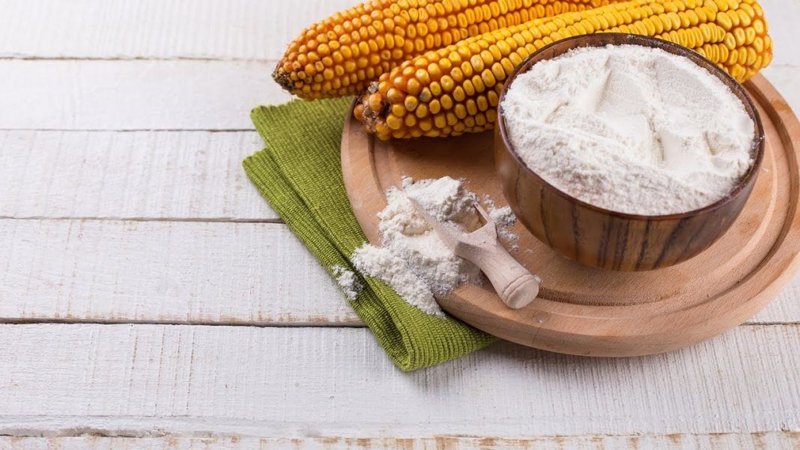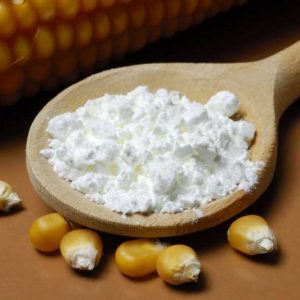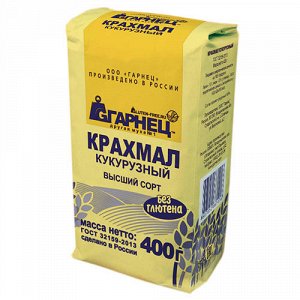What are the benefits of corn starch, and how it differs from potato
Starch is a natural thickener, it is used to make jelly and sauces. In Russia, the most popular potato, but there are other types that differ in chemical composition and have their own advantages and disadvantages. Let's figure out which starch is better - potato or corn.
The content of the article
Potato starch
Carbohydrates are the main sources of energy for humans. Potato starch is widely used as a thickener, so many housewives have this product in the kitchen. It is also used in cosmetology, medicine, textile and paper industries.
What it is

Potato carbohydrate is obtained from tubers by washing and grinding. It consists of amylopectin and amylose. If you rub it between your fingers, you can feel a slight crunch of small particles. Upon contact with cold water, the product does not dissolve, but forms a viscous bulk - paste.
The product belongs to the group of polysaccharides, it contains high molecular weight carbohydrates that serve as structural components of cells and tissues.
What does it look like
It is a fine free-flowing white powder. When diluted, it does not change the color of water, juice or sauce, so it is most often used as a thickener in the preparation of transparent liquid products. It has a weakly expressed specific taste - this is taken into account when added to jelly and sauces.
Advantages and disadvantages
Advantages of potato starch:
- Colorless and therefore suitable for lightly colored dishes.
- Forms a paste with high viscosity, thickens at a low temperature.
- Reduces the amount of bad cholesterol in the blood and removes excess fluid from the body.
- Relieves inflammation in the stomach and envelops its walls, protecting it from the effects of rough food.
Disadvantages:
- Thinns in large quantities and can spoil the dish.
- Excessive consumption of the product leads to an increase in blood sugar levels and hormonal disorders.
- Potato starch contains gluten, so it is contraindicated for people with celiac disease.
Corn starch
Grain-derived starch corn, more suitable for cooking where high viscosity is not required. For example, creams and soups will turn out to be stringy and liquid, and adding it to baked goods makes the dough more fluffy.
What it is
In corn kernels, starch is formed as a result of photosynthesis. 90% consists of complex carbohydrate compounds, also contains proteins, fats and vitamins. Scope of application:
- Add to sauces, dressings, yoghurts, mashed potatoes, etc.

- Used as an emulsifier in spreads and margarine.
- Add to sausages to reduce moisture.
There are two types:
- simple is obtained by soaking in sulfuric acid, grinding and drying the grains;
- modified - by additional processing of simple.
What does it look like
It is a loose, odorless yellowish powder. A quality product tastes like corn, but without the pronounced taste of grains. Cornstarch is very similar to flour, which is why they are used interchangeably. Swells quickly in hot and cold water and becomes viscous.
Advantages and disadvantages
The benefits of this product are still hotly debated among dietitians. But still, many experts are sure that the use of small doses is good for the body:
- It removes toxins and toxins from the body, activates the growth of muscle mass.
- Improves the condition of blood vessels, therefore it is recommended for problems of the cardiovascular system.
- It has diuretic and choleretic properties, anti-inflammatory effect.
- Does not allow glucose to be absorbed into the blood for a long time, so it is useful to use it in diabetes.
Disadvantages:
- Harmful to the body with individual intolerance to the product.
- High-calorie, therefore, contraindicated in obesity.
There are two types of cornstarch:
- natural is obtained from fruits and vegetables;
- refined - by chemical processing, therefore, with frequent use, it harms the body.
How are they similar?
The chemical composition of corn and potato starch is practically the same - they both consist of amylose and amylopectin.
The consistencies are also similar: both products are in powder form with a slight odor and a faint taste. Both form gel-like structures, although potato has more stickiness.
What is the difference between corn starch and potato
Visually, corn starch differs from potato in structure and color. Processed potatoes acquire a snow-white color and fine-crystalline structure, while corn becomes yellowish-white and resembles flour in consistency.
When corn starch is added to hot water, a cloudy consistency is obtained, and potato starch does not change the color of the water. Heating the second produces a thick, sticky paste, while the former remains practically liquid and can restore its structure.
Attention! The lack of gluten in cornstarch allows it to be consumed even by those on a gluten-free diet.
Is it possible to replace one with another
It is impossible to replace one type of starch with another. Unlike corn, potato is a strong thickener. For example, if you add it to the dough instead of corn dough, it will turn out to be too thick and tight.
If corn starch is added to the jelly instead of potato starch, it will be too liquid. The color of these products also differs - corn colors clear liquids.
Where is what starch is used

Corn starch is widely used in cooking and confectionery. When added to the dough, a less dry and more tender biscuit is obtained.
The polysaccharide derived from corn kernels is less viscous than potato polysaccharides, gives a smooth consistency and is great for making liquid sauces and desserts.
Potato starch forms a more viscous paste and is used for making transparent cream soups and jelly. Also, this product absorbs excess liquid, so it is added when baking fruit and curd cakes.
It is interesting:
Where and how to store corn on the cob at home.
Which one is more useful
Potato starch is easily absorbed by the body and has a beneficial effect on the digestive tract. The jelly made on its basis envelops the walls of the stomach and provides the body with energy.
Corn carbohydrates are gluten-free. Therefore, it is recommended for people with diabetes. If you eat food rich in cornstarch for breakfast, even in the evening there is no increase in blood sugar levels.
Reference. Cornstarch is considered healthier, but potato is the best thickener.
Conclusion
In the past, the most popular was potato starch, but lately people are increasingly using gluten-free corn starch. When added to water, both of them acquire a viscous consistency.But potato starch is more suitable as a thickener, and corn starch is more suitable for making biscuits, cakes, sauces.